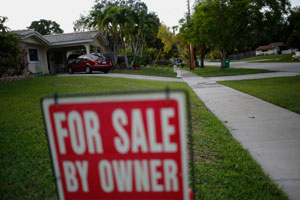Sales of Existing Homes Climb to Highest Level in 8 Years

Sales of previously owned U.S. homes climbed to an eight-year high in June as momentum in the residential real estate market accelerated.
Closings on existing homes, which usually occur a month or two after a contract is signed, climbed 3.2% to a 5.49 million annualized rate, the most since February 2007, the National Association of Realtors said July 22. Prices rose to a record amid tight supply.
The housing market has picked up in recent months as more jobs, historically low mortgage rates and greater household formation boosts demand. Faster wage growth will be needed to help housing continue its recovery and become a bigger contributor to growth this year.
“We’re getting ready to embark on one of the strongest bursts in activity in the housing market that we’ve seen since the recession ended,” Mark Vitner, senior economist at Wells Fargo Securities in Charlotte, North Carolina, said before the report. “I’m very optimistic about housing in the second half of the year.”
Estimates for the pace of sales in the Bloomberg survey of 76 economists projected a gain to a 5.4 million pace in June. Forecasts ranged from 5.2 million to 5.52 million. The Realtors’ group revised May’s rate to 5.32 million from a previously reported 5.35 million.
Compared with a year earlier, purchases increased 9.6% in June on an adjusted basis.
The median price of an existing home rose 6.5% from June 2014 to $236,400, the highest on record before adjusting for inflation.
The number of existing properties on the market rose to 2.3 million in June compared with 2.28 million at the end of May. At the current pace, it would take five months to sell those houses compared with 5.1 months at the end of May.
The median time a home was on the market was 34 days, the fewest in records going back four years.
“The market is tighter compared to last year,” Lawrence Yun, NAR chief economist, said in a news conference July 22 as the figures were released. “Home values are rising too fast, and we need more supply to bring the price growth down, consistent with income growth.”
Purchases of existing homes increased in all four regions, led by a 4.7% gain in the Midwest.
Investors are leaving the market, and the share of first-time buyers is holding around 30%, which means transactions are being driven by existing homeowners looking to relocate, Yun said.
The housing market has strengthened as of late, bolstered by a job market that’s added almost 3 million workers to payrolls over the past year. At 5.3%, the unemployment rate is bumping up against the level that Federal Reserve policymakers consider full employment.
Fed officials are monitoring progress in the economy as they consider when to raise their benchmark interest rate for the first time since 2006. In congressional testimony last week, Chair Janet Yellen said “homebuilding has picked up somewhat lately, although the demand for housing is still being restrained by limited availability of mortgage loans to many potential homebuyers.”
That makes it harder for them to take advantage of mortgage rates that remain at historically low levels. The average rate for a 30-year fixed mortgage was 4.09% in the week ended July 16, according to data from Freddie Mac in McLean, Virginia. While that’s the highest since October, it compares with the 6.06% average in the five years before the last recession began.
Homebuilders are optimistic about their industry’s prospects. The National Association of Home Builders/Wells Fargo sentiment gauge held in July at the highest level since November 2005 as the sales outlook climbed to the highest in a decade.
Such attitudes may be prompting them to boost construction, which would help alleviate a dearth of new and existing available properties. Housing starts rose 9.8% to a 1.17 million annualized rate, the second-highest level since November 2007, as ground-breaking on multifamily dwellings jumped 29.4%.


